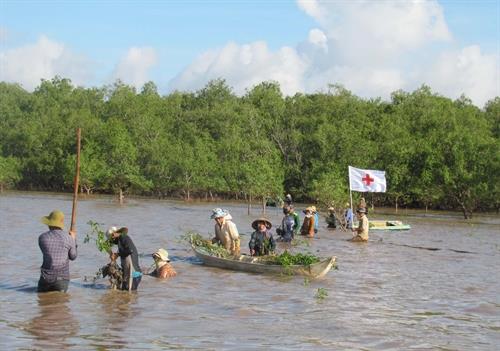 Society
Society

The co-management model for mangrove forest protection in Sóc Trăng Province has improved livelihoods in local communities and efficiently protects forests.

|
| Mangrove forests in Sóc Trăng Province’s Trần Đề District. — VNA/VNS Photo Trung Hiếu |
SÓC TRĂNG — The co-management model for mangrove forest protection in Sóc Trăng Province has improved livelihoods in local communities and efficiently protects forests.
Located south of the Hậu River, the southern-most tributary of the Mekong River, Sóc Trăng has faced the impacts of climate change, including coastal erosion.
Human activities like overexploitation of aquatic resources in mangrove forests have caused the degradation of those forests which act as shields preventing erosion of coasts.
To grow mangrove forests, the province launched the co-management model in Âu Thọ B Hamlet in Vĩnh Châu Town’s Vĩnh Hải Commune in 2007.
Under it, local people together with authorities protect the forests and exploit aquatic resources and wood.
Thạch Soal, head of the Âu Thọ B Hamlet co-management group, said: “Previously local people who came into mangrove forests to exploit aquatic resources were not aware of the need to protect forests and even cut trees.”
As a result, coastal areas eroded and this impacted the livelihoods and agricultural production of local people, he said.
After participating in the co-management model, people have begun to protect mangrove forests and exploit aquatic resources properly since they now understand mangroves provide them with their livelihood, he added.
Besides protecting forests, locals have also planted more trees.
Nguyễn Thanh Toàn, deputy chairman of Vĩnh Hải Commune's People’s Committee, said after the co-management model was adopted, mud flats have been developed and mangrove forests are being grown densely.
People are benefiting more from the forests’ aquatic resources, he added.
After its success in Âu Thọ B, the model has been expanded to the province’s other coastal districts like Trần Đề and Cù Lao Dung.
In Cù Lao Dung’s An Thạnh Nam Commune, forest rangers and locals protect nearly 600ha of mangrove forests, which have prevented erosion.
Thạch Sơn, head of the commune's co-management group, said for locals, “Protecting forests is protecting their livelihoods.”
Besides protecting mangrove forests, locals also breed aquatic species like obtuse horn shell and mud clams in mangrove forests to improve their incomes.
Trần Trọng Khiêm, head of the province's Forest Protection Sub-department, said people’s awareness of the importance of mangrove forests has increased significantly after participating in the co-management model.
They voluntarily co-operate with authorities to protect and grow mangroves, he said.
The co-management model has helped protect the forests and improve incomes for people, he added.
The province has 1,500ha of mangrove forests under the co-management model, according to the sub-department.
Its mangrove cover has increased from 5,500ha in 2011 to nearly 8,000ha now. VNS




